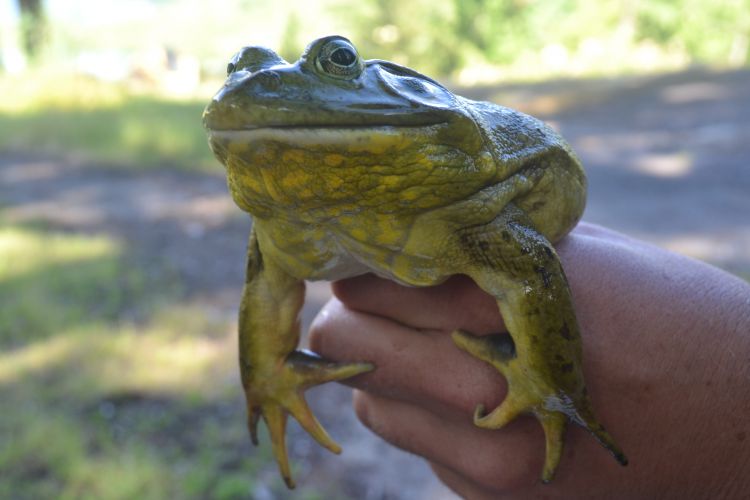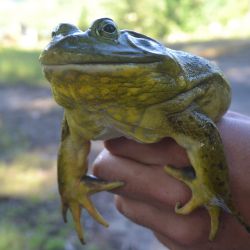
Priority: Prevent
General: Large frog that was first introduced to farm for food. The meat on the legs were the source.
Size: Up to 20 cm long from nose to end of the body (not including legs).
Colour: Olive to bright green on back & sides. Creamy white on underside, sometimes with grey or dark markings. In mating season, mature males have a bright yellow throat.
Special Features: They have distinct skin folds called tympanum behind and below the eye. Males tympanums are twice as large as their eyes. Females’ are about the same size as their eye. Their eyes are large & golden colour.
Green Frogs (Lithobates clamitans), a native species.
Differences: The native green frogs are definitely smaller in size than American bullfrog. They have the tympanum skin folds but also folds that extend along the body. American bullfrogs lack the skin folds along the body.
Where did it come from? Eastern North America.
Where does it live here? Introduced to southwestern BC as a food source and then were released. American Bullfrogs are well established in BC. There are populations on Vancouver Island, some Gulf Islands, the Lower mainland and the Kootenay region. They prefer warm ponds and lakes that are weedy but also can be found in ditches and slow-moving streams. They do well in areas that are disturbed by humans.
Bullfrogs float just beneath the water’s surface. Their eyes and green snouts can be seen. The call of a male can travel up to 1km. The BC Government website has a recording of its call here.
Reproduction: Females deposit floating egg masses. One female can deposit as many as 20,000 eggs.
When does it reproduce & mature? Breeding happens in May-July. Females deposit eggs and males fertilize the egg masses. Four days after fertilization, tadpoles emerge from the eggs. It can take up to 3 years for the tadpoles to become frogs. It takes 3-5 years for adults to become sexually mature. Adults breed only once per year. The average lifespan is 7-9 years.
Spreads By: Humans have been known to move this species around. Networks of streams and lakes can allow tadpoles and bullfrogs to move into new water bodies and areas. They can also travel over land and eat a variety of prey like other frogs & birds.
Species Type: Amphibian
- American Bullfrogs can take over habitat where native frogs usually live. The tadpoles also compete with the food and habitat that native tadpoles need.
- Bullfrogs eat native frogs as well as birds, insects, snakes and other mammals. Due to their huge appetite, they have the potential to dramatically change ecosystems that they have infested.
- Bullfrogs can spread a type of fungus that is causing declining amphibian numbers.
- REPORT all sightings. Contact LRISS if you see or hear an American Bullfrog. Contact the BC provincial Frog Watch program: http:/www.env.gov.bc.ca/wld/frogwatch/
- Don’t Let it Loose: Don’t let any pet loose because it can become invasive.
- Pets: Do not have American Bullfrogs as pets. Do not breed them or release them.
- Collection: Do not collect any tadpoles and move them to a new place.
- Ponds: Make your backyard pond attractive to native frogs. Do not stock ponds with aquarium frog species.
Okanagan Invasive Species Online: American Bullfrog
Government of British Columbia. Invasive Species Alert! American Bullfrogs.
Guide to Amphibians, Frogs, Toads, Salamanders of Vancouver Island & the Gulf Islands. Brochure. Developed by Kristiina Ovaska and Purnima Govindarajulu. Produced by B.C. Frog Watch of British Columbia Ministry of Environment and Salt Spring Conservancy.
All photos by Rylee Murray.
